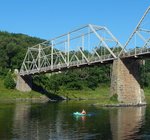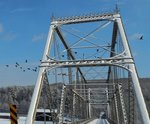, 0°
Wind: mph
My favorite place in the Upper Delaware Valley is a picturesque eddy of flat water above Skinners Falls, known since the 1870s as the “Milanville Eddy.” Here log rafts were pegged …
Stay informed about your community and support local independent journalism.
Subscribe to The River Reporter today. click here
This item is available in full to subscribers.
Please log in to continue |




My favorite place in the Upper Delaware Valley is a picturesque eddy of flat water above Skinners Falls, known since the 1870s as the “Milanville Eddy.” Here log rafts were pegged together starting in Colonial times, and river men paused to gauge water levels before confronting Skinners Falls.
Here, too, despite a spate of recent closings, our beautiful 1901 bridge still links Milanville to New York’s historic Erie Railroad, its former rail bed serving Conrail in 1976 and now a “short-line” freight hauler.
But like every motorist in a hurry, I’ve crossed to New York for decades without giving a thought to the bridge’s labyrinth of steel, or trying to guess who erected it. Until, in December of 2015, without prior notice, PennDOT closed the Milanville Bridge “indefinitely,” reporting, “It won’t be something that’s going to be just weeks or even months; it’s going to be a while.”
Then, deluged with 1,400 signatures from the Milanville General Store and 800 on-line petitions, the agency found emergency funds to repair and re-open the bridge in 2016. Its engineers have also promised to “study” three options for the site: no bridge; a new bridge; or how to refurbish the historic bridge.
Locally, public agencies have responded as follows:
• The Upper Delaware Council, representing local townships, has strongly urged PennDOT to preserve “this treasured resource.”
• Route 97 Scenic Byway has urged PennDOT to preserve the bridge, citing its “well-deserved listing on the National Register of Historic Places.”
• Alone among Scenic River management agencies, the National Park Service (NPS) does not publicly support preserving the 1901 bridge.
To understand why, I’ve studied a chart used by NPS Region III’s Philadelphia office in setting priorities for the Upper Delaware Scenic and Recreational River.
A big hurdle for the bridge is that Region III staff requires us to “associate” it with a “significant event, important person, or cultural activity,” and avows there aren’t any for Milanville.
I question this, and have printed below a list of persons and events that had a role in construction of the Milanville Bridge.
1900. World-famous financier J.P. Morgan creates the American Bridge Co. (“Ambridge”).
1901. PA and NY charter Milton Skinner’s Milanville Bridge Company.
1901. Morgan & Andrew Carnegie make Ambridge a subsidiary of Carnegie’s U.S. Steel Corp.
1901. The Milanville Bridge Company hires Ambridge, which begins construction.
1902. Ambridge completes the Milanville Bridge, one of its first projects.
It’s troubling that Region III has ignored Milanville’s link to the American Bridge Company and its world-famous founders.
Within decades of erecting its one-lane bridge at Milanville, Ambridge was building many of the world’s giant bridges and skyscrapers, from Oakland, CA’s 4.5-mile-long Bay Bridge to New York’s Verrazano Narrows Bridge and Empire State Building.
To gain Region III’s imprimatur, I’m guessing J.P. Morgan and Andrew Carnegie should have lunched at the Milanville Store, christened our bridge and signed autographs.
NPS also downplays the Milanville Bridge by declaring that, “while rare,” it’s “not one-of-a-kind in the region or the best of the best examples.”
Which is humbug.
1. The Milanville Bridge is listed twice on the National Register of Historic Places: nominated in 1982 by Pennsylvania and in 1988 by NPS historian Mary Curtis.
2. In Milanville, Ambridge engineers experimented with truss work designed for B&O and Pennsylvania railroad bridges. But then, from 1902 to 1930, it erected just three similar bridges for highway use.
Today, two are open in New England, plus ours at Milanville.
3. Among 277 “Baltimore through truss” bridges erected by all builders, 12 are listed on the National Register of Historic Places, with just three functioning as highway bridges in 2018: at Milanville, Steubenville NY, and in Nebraska.
To claim the Milanville Bridge isn’t “one of a kind” in its region is to wear blinders.
It’s most eloquently championed on the website of HistoricBridges.org.
“This utterly spectacular bridge would stand out as an extremely ornate, beautiful and significant metal truss bridge if it were located even in the most truss-dense region in the country…[its] local rarity and importance should not be understated.”
With demolition slated for a beautiful 1904 truss bridge at Pond Eddy, the Milanville Bridge is also the last of its kind on our Scenic River.
It requires support—rather than indifference—from the National Park Service.
For links to a full-length, detailed story by Ed Wesely about the Milanville Bridge, its history and the reasons for preserving it, visit https://riverreporter.com/nps-cultural-resource-criteria-critique.
Comments
No comments on this item Please log in to comment by clicking here